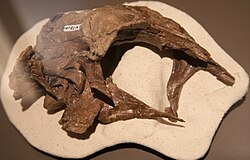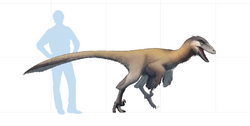Biology:Latenivenatrix
| Latenivenatrix | |
|---|---|

| |
| Hind part of assigned skull TMP 1982.019.0023, Royal Tyrrell Museum | |
| Scientific classification | |
| Domain: | Eukaryota |
| Kingdom: | Animalia |
| Phylum: | Chordata |
| Clade: | Dinosauria |
| Clade: | Saurischia |
| Clade: | Theropoda |
| Family: | †Troodontidae |
| Subfamily: | †Troodontinae |
| Genus: | †Latenivenatrix |
| Type species | |
| Latenivenatrix mcmasterae van der Reest and Currie, 2017
| |
Latenivenatrix (meaning "hiding hunter") is a genus of troodontid known from one species, L. mcmasterae, described in 2017 from remains formerly identified as Troodon. With an estimated skull length of 45 centimetres (18 in) and a full body length of 3–3.5 metres (9.8–11.5 ft), Latenivenatrix is the largest troodontid known.[1]
Discovery and specimens
The type specimen or holotype of Latenivenatrix (CMN 12340) was originally described in 1969 by Dale Alan Russell and referred by him to the genus Stenonychosaurus. In 1987 it was referred to Troodon. It had been collected in 1968 by Irene Vanderloh in the Dinosaur Park Formation strata from Alberta, southern Canada . The specimen has preserved some skull bones (frontals, parietals, postorbital, basioccipital and basisphenoid), four vertebra and four ribs, some chevrons and gastralia, fairly complete forelimb and incomplete hindlimbs.
Moreover, three additional specimens coming from the same locality are referred to the same species. These include UALVP 55804 (a partial pelvis), TMP 1982.019.0023 (a partial skull), and TMP 1992.036.575 (a right dentary and several left metatarsals).
As Latenivenatrix can be distinguished from Stenonychosaurus due to the structure of its frontals and metatarsal III, several isolated examples of these types of bones have also been referred to Latenivenatrix. Referred frontal specimens include CMN 12340, TMP 1979.008.0001, TMP 1980.016.1478, TMP 1986.036.0004, and UALVP 55285, along with a metatarsal III (TMP 1997.133.0008). [1]
Description
Latenivenatrix can be distinguished by other troodontids thanks to the following diagnostic (autapomorphic) traits residing in the pelvis:
- The pubis is retroverted forming a 17° angle;
- The pubic shaft is anteriorly curved;
- A large muscle scar on the lateral surface of the pubic shaft is present, slightly proximal to the pubic boot (this is seen also in dromaeosaurid Hesperonychus).
Other diagnostic traits that further distinguish Latenivenatrix from other derivate troodontids (particularly its close relative Stenonychosaurus) are:
- The triangular shape of each frontal bone which also does have a single deep groove in the frontonasal contact surface;
- A concave anterior surface of metatarsal III. While this trait is clearly absent in other derived troodontids such as Saurornithoides, Talos, Urbacodon and Stenonychosaurus too, it appears to be present in Philovenator as well and not clearly verifiable in several species.[1]
Phylogeny
Latenivenatrix was found to be a derived troodontid (part of the newly-defined Troodontinae), probably related to coeval Asian forms such as Linhevenator and Philovenator.[1]
Paleobiology
Latenivenatrix is the largest troodontid known, with a maximum total body length estimated to 3.5 m (11.5 ft). As a derivate troodontid, it was probably a semi-omnivorous bipedal with loss of the skills of a primitive flyer. Its ecological role was probably distinct from that of Stenonychosaurus, the other smaller kind of troodontid known from the same formation. The two species can be distinguished by abovementioned morphological differences.[1]
Paleopathology
A parietal bone catalogued as TMP 79.8.1 bears a "pathological aperture". In 1985 Phil Currie hypothesized that this aperture was caused by a cyst, but in 1999 Tanke and Rothschild interpreted it as a possible bite wound. One hatchling specimen may have suffered from a congenital defect resulting in the front part of its jaw being twisted.[2]
See also
References
- ↑ 1.0 1.1 1.2 1.3 1.4 van der Reest, A. J.; Currie, P. J. (2017). "Troodontids (Theropoda) from the Dinosaur Park Formation, Alberta, with a description of a unique new taxon: implications for deinonychosaur diversity in North America". Canadian Journal of Earth Sciences: 919–935. doi:10.1139/cjes-2017-0031. http://www.nrcresearchpress.com/doi/abs/10.1139/cjes-2017-0031#.WYnhUlGGOUm.
- ↑ Molnar, R. E., 2001, Theropod paleopathology: a literature survey: In: Mesozoic Vertebrate Life, edited by Tanke, D. H., and Carpenter, K., Indiana University Press, p. 337-363.


